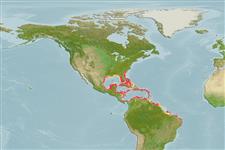Actinopterygii (ray-finned fishes) >
Perciformes (Perch-likes) >
Haemulidae (Grunts) > Haemulinae
Etymology: Haemulon: Greek, haimaleos = bloody (Ref. 45335).
Environment / Climate / Range
Ecology
Marine; reef-associated; depth range 3 - 50 m (Ref. 9626). Subtropical, preferred ?; 33°N - 12°S, 98°W - 34°W
Western Atlantic: Bermuda, southeastern Florida (USA), and the Bahamas to Brazil.
Length at first maturity / Size / Weight / Age
Maturity: Lm 19.0 range ? - ? cm
Max length : 33.0 cm TL male/unsexed; (Ref. 7251); common length : 25.0 cm TL male/unsexed; (Ref. 3798); max. published weight: 550.00 g (Ref. 5217)
Dorsal
spines
(total): 12;
Dorsal
soft rays
(total): 15-17;
Anal
soft rays: 8. Broad black area above line from dorsal fin origin to tip of lower caudal fin lobe, including upper part of caudal peduncle and both lobes of tail. Striking colored species, with a silvery body, black back and tail (Ref. 26938). With narrow yellow stripes, the broadest mid-lateral (Ref. 13442).
Inhabits clear inshore and offshore reefs (Ref. 9710) and adjacent grass beds, often in schools (Ref. 3798). Feeds on crustaceans (Ref. 3798). Marketed fresh (Ref. 3798).
Oviparous, distinct pairing during breeding (Ref. 205).
Robins, C.R. and G.C. Ray, 1986. A field guide to Atlantic coast fishes of North America. Houghton Mifflin Company, Boston, U.S.A. 354 p. (Ref. 7251)
IUCN Red List Status (Ref. 115185)
CITES (Ref. 94142)
Not Evaluated
Threat to humans
Reports of ciguatera poisoning (Ref. 30303)
Human uses
Fisheries: minor commercial; aquarium: public aquariums
More information
ReferencesAquacultureAquaculture profileStrainsGeneticsAllele frequenciesHeritabilityDiseasesProcessingMass conversion
Tools
Can't connect to MySQL database fbquizv2. Errorcode: Too many connections
